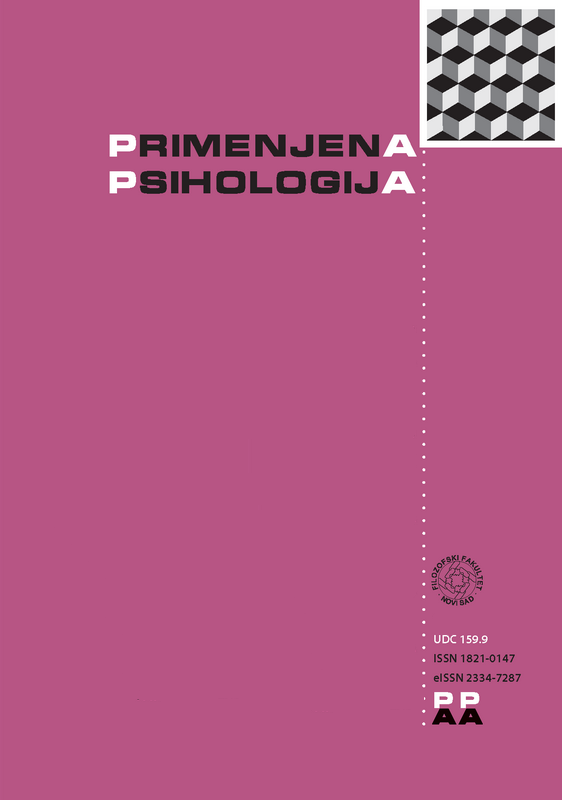RELATION BETWEEN CREATIVITY AND TENDENCY TOWARD PSYCHOPATHOLOGY IN THE LIGHT OF A SHARED VULNERABILITY MODEL
DOI:
https://doi.org/10.19090/pp.2016.3.273-291Keywords:
creativity, psychopathology, Shared vulnerability modelAbstract
The aim of this study was to explore a model of shared vulnerability, which explains the relationship between creativity and psychopathology using three groups of variables: 1) protective factors (high IQ, good working memory, and high cognitive flexibility), 2) risk factors (lower IQ performance, poor working memory capacity, and cognitive rigidity), and 3) shared vulnerability factors (openness to experience, hyperconnectivity, and low latent inhibition). The research was conducted on 151 participants, mean age 18.56. Subjects completed the tasks from the Divergent Thinking Test, the items from the Clinical Outcomes in Routine Evaluation – Outcome Measure (CORE-OM), Raven’s Advanced Progressive Matrices, the Digit Symbol Coding task from the WAIS, the Trail Making Test (TMT), the Big Five Inventory (BFI), a synesthesia questionnaire, and a latent inhibition task. Two hierarchical regressions were performed, and the results showed that significant predictors of creativity were Openness to Experience, a tendency towards synesthesia, latent inhibition and, marginally, working memory. Symptoms of different disorders were significantly predicted by low working memory capacities and marginally by a tendency toward synesthesia. Our results partially support the hypothesis of the shared vulnerability model, but also suggest some new questions for further research.Metrics
References
Amabile, T. M. (1996). Creativity in context. Boulder, CO: Westview.
Babcock, R. L. (1994). Analysis of adult age differences on the Raven's Advanced Progressive Matrices Test. Psychology and Aging, 9, 303−314. doi:10.1037/0882-7974.9.2.303
Batey, M., Chamorro-Premuzic, T., & Furnham, A. (2009). Intelligence and personality as predictors of divergent thinking: The role of general, fluid and crystallised intelligence. Thinking Skills and Creativity, 4, 60−69. doi:10.1016/j.tsc.2009.01.002
Berger, J., Marković, M. i Mitić, M. (1994). Priručnik za Vekslerov Individualni Test Inteligencije. Beograd: Centar za primenjenu psihologiju Društva psihologa Srbije.
Burch, G. St. J., Hemsley, D. R., Corr, P. J., & Pavelis, C. (2005). Personality, creativity, and latent inhibition. European Journal of Personality, 19, 1–16. doi:10.1002/per.572
Burch, G. St. J., Pavelis, C., Hemsley, D. R., & Corr, P. J. (2006). Schizotypy and creativity in visual artists. British Journal of Psychology, 97, 177–190. doi:10.1348/000712605X60030
Carson, S. (2012). The unleashed mind: Why creative people are eccentric. Preuzeto 20. 01. 2012. sa http://www.scientificamerican.com/article.cfm?id=the-unleashed-mind
Carson, S. H. (2011). Creativity and psychopathology: A shared vulnerability model. The Canadian Journal of Psychiatry, 56, 144–153. doi:10.1017/cbo9781139128902.017
Chávez-Eakle, R. A., Lara, M. C., & Cruz-Fuentes, C. (2006). Personality: A possible bridge between creativity and psychopathology? Creativity Research Journal, 18, 27–38. doi:10.1207/s15326934crj1801_4
Evans, C., Connell, J., Barkham, M., Margison, F., McGrath, G., Mellor-Clark, J., & Audin, K. (2002). Towards a standardised brief outcome measure: Psychometric properties and utility of the CORE–OM. British Journal of Psychiatry, 180, 51–60. doi:10.1192/bjp.180.1.51
Feist, G. J. (1998). A meta-analysis of personality in scientific and artistic creativity. Personality and Social Psychology Review, 4, 290–309. doi:10.1207/s15327957pspr0204_5
Flaherty, A. W. (2011). Brain illness and creativity: Mechanisms and treatment risks. The Canadian Journal of Psychiatry, 56, 132–143. doi:10.1177/070674371105600303
John, O. P., Donahue, E. M., & Kentle, R. L. (1991). The Big Five Inventory − Versions 4a and 54. Berkeley, CA: University of California, Berkeley, Institute of Personality and Social Research.
Kostić, A. (2006). Kognitivna psihologija. Beograd: Zavod za udžbenike i nastavna sredstva.
Kvaščev, R. (1975). Podsticanje i sputavanje stvaralačkog ponašanja ličnosti. Sarajevo: Zavod za udžbenike Svjetlost.
Kvaščev, R. (1976). Psihologija stvaralaštva. Beograd: Beogradski izdavačko grafički zavod.
Lezak, M. D. (1995). Neuropsychological assessment (3rd ed.). New York: Oxford University Press.
Lezak, M. D. (1982). The test-retest stability and reliability of some tests commonly used in neuropsychological assessment. Paper presented at the Fifth European Conference of the International Neuropsychological Society, Deauviile, France.
Lynn, R., Allik, J., & Irwing, P. (2004). Sex differences on three factors identified in Raven’s Standard Progressive Matrices. Intelligence, 32, 411–424. doi:10.1016/j.intell.2004.06.007
Raven, J. C., Court, J. H., & Raven, J. (1994). Advanced progressive matrices: Sets I and II. Manual for Raven’s Progressive Matrices and Vocabulary scales. Oxford, England: Oxford Psychologists Press.
Reitan, R. (1958). Validity of the Trail Making test as an indicator of organic brain damage. Perceptual and Motor Skills, 8, 271−276. doi:10.2466/pms.1958.8.3.271
Rodan, S., & Galunic, C. 2004. More than network structure: How knowledge heterogeneity influences managerial performance and innovativeness. Strategic Management Journal, 25, 541–562. doi:10.1002/smj.398
Rotenberg, A. (2010). Kreativnost i ludilo: Nova otkrića i stari stereotipi. Beograd: Clio.
Runco, A. M. (2003). Education for creative potential. Scandinavian Journal of Educational Research, 47, 318–324. doi:10.1080/00313830308598
Schuldberg, D. (2001). Six subclinical spectrum traits in normal creativity. Creativity Research Journal, 13, 5–16. doi:10.1207/S15326934CRJ1301_2
Shalley, E. C., Zhou, J., & Oldham, R. G. (2004). The effects of personal and contextual characteristics on creativity: Where should we go from here? Journal of Management, 30, 933−958. doi:10.1016/j.jm.2004.06.007
Silvia, P. J. (2008). Creativity and intelligence revisited: A latent variable analysis of Wallach and Kogan (1965). Creativity Research Journal, 20, 34−39. doi:10.1080/10400410701841807
Simonton, D. K. (2005). Creative method in the madness: The connection between creativity and psychopathology. Davis: University of California.
Spreen, O., & Strauss, E. (1998). A compendium of neuropsychological tests: Administration, norms and commentary (2nd ed.). New York: Oxford University Press.
Sussman, A. (2007). Mental illness and creativity: A neurological view of the “Tortured Artist”. Stanford Journal of Neuroscience, 1, 21–24.
Tierney, P., & Farmer, S. M. (2002). Creative self-efficacy: Potential antecedents and relationship to creative performance. Academy of Management Journal, 45, 1137–1148. doi:10.2307/3069429
Tombaugh, T. N. (2004). Trail Making Test A and B: Normative data stratified by age and education. Archives of Clinical Neuropsychology, 19, 203–214. doi:10.1016/S0887-6177(03)00039-8
University of Sussex. (2012). Synaesthesia Research. Preuzeto 15.03. 2012. sa https://www.survey.bris.ac.uk/sussex/syn
Van Campen, C., & Froger, C. (2003). Personal profiles of color synesthesia: Developing a testing method for artists and scientists. Leonardo, 36, 291–294. doi:10.1162/002409403322258709
Wuthrich, V., & Bates, T. C. (2001). Schizotypy and latent inhibition: Non-linear linkage between psychometric and cognitive markers. Personality and Individual Differences, 30, 783–798. doi:10.1016/S0191-8869(00)00071-4







